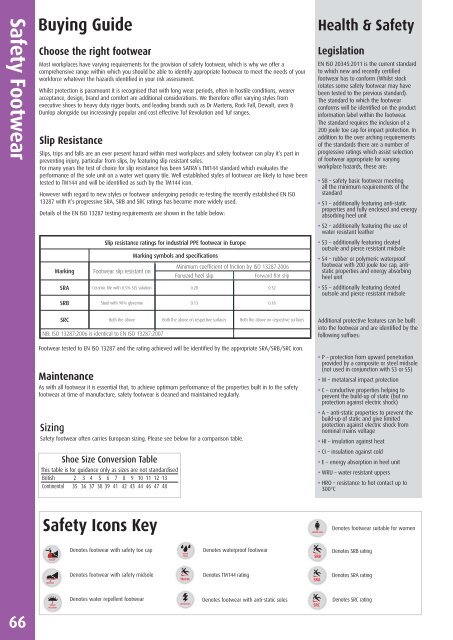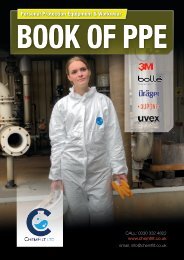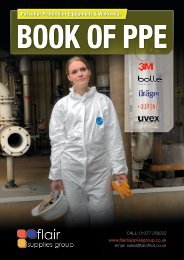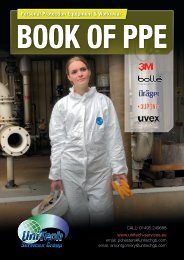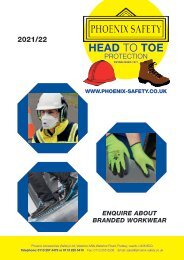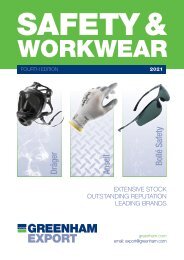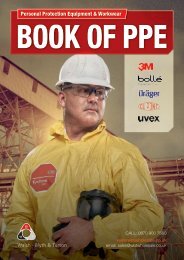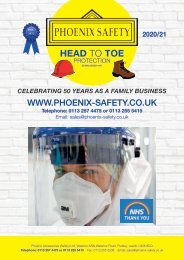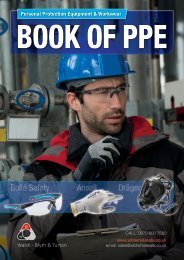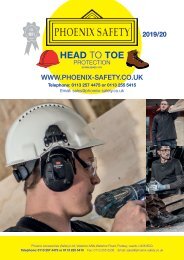Phoenix PPE Catalogue
Phoenix PPE Catalogue
Phoenix PPE Catalogue
Create successful ePaper yourself
Turn your PDF publications into a flip-book with our unique Google optimized e-Paper software.
Safety Footwear<br />
Buying Guide<br />
Choose the right footwear<br />
Most workplaces have varying requirements for the provision of safety footwear, which is why we offer a<br />
comprehensive range within which you should be able to identify appropriate footwear to meet the needs of your<br />
workforce whatever the hazards identified in your risk assessment.<br />
Whilst protection is paramount it is recognised that with long wear periods, often in hostile conditions, wearer<br />
acceptance, design, brand and comfort are additional considerations. We therefore offer varying styles from<br />
executive shoes to heavy duty rigger boots, and leading brands such as Dr Martens, Rock Fall, Dewalt, uvex &<br />
Dunlop alongside our increasingly popular and cost effective Tuf Revolution and Tuf ranges.<br />
Slip Resistance<br />
Slips, trips and falls are an ever present hazard within most workplaces and safety footwear can play it’s part in<br />
preventing injury, particular from slips, by featuring slip resistant soles.<br />
For many years the test of choice for slip resistance has been SATRA’s TM144 standard which evaluates the<br />
performance of the sole unit on a water wet quarry tile. Well established styles of footwear are likely to have been<br />
tested to TM144 and will be identified as such by the TM144 icon.<br />
However with regard to new styles or footwear undergoing periodic re-testing the recently established EN ISO<br />
13287 with it’s progressive SRA, SRB and SRC ratings has become more widely used.<br />
Details of the EN ISO 13287 testing requirements are shown in the table below:<br />
Marking<br />
Slip resistance ratings for industrial <strong>PPE</strong> footwear in Europe<br />
Footwear slip resistant on<br />
Marking symbols and specifications<br />
Footwear tested to EN ISO 13287 and the rating achieved will be identified by the appropriate SRA/SRB/SRC icon.<br />
Maintenance<br />
As with all footwear it is essential that, to achieve optimum performance of the properties built in to the safety<br />
footwear at time of manufacture, safety footwear is cleaned and maintained regularly.<br />
Sizing<br />
Safety footwear often carries European sizing. Please see below for a comparison table.<br />
Shoe Size Conversion Table<br />
This table is for guidance only as sizes are not standardised<br />
British 2 3 4 5 6 7 8 9 10 11 12 13<br />
Continental 35 36 37 38 39 41 42 43 44 46 47 48<br />
Minimum coefficient of friction by ISO 13287:2006<br />
Forward heel slip<br />
Forward flat slip<br />
SRA Ceramic tile with 0.5% SLS solution 0.28 0.32<br />
SRB Steel with 90% glycerine 0.13 0.18<br />
SRC Both the above Both the above on respective surfaces Both the above on respective surfaces<br />
NB: ISO 13287:2006 is identical to EN ISO 13287:2007<br />
Health & Safety<br />
Legislation<br />
EN ISO 20345:2011 is the current standard<br />
to which new and recently certified<br />
footwear has to conform (Whilst stock<br />
rotates some safety footwear may have<br />
been tested to the previous standard).<br />
The standard to which the footwear<br />
conforms will be identified on the product<br />
information label within the footwear.<br />
The standard requires the inclusion of a<br />
200 joule toe cap for impact protection. In<br />
addition to the over arching requirements<br />
of the standards there are a number of<br />
progressive ratings which assist selection<br />
of footwear appropriate for varying<br />
workplace hazards, these are:<br />
• SB – safety basic footwear meeting<br />
all the minimum requirements of the<br />
standard<br />
• S1 – additionally featuring anti-static<br />
properties and fully enclosed and energy<br />
absorbing heel unit<br />
• S2 – additionally featuring the use of<br />
water resistant leather<br />
• S3 – additionally featuring cleated<br />
outsole and pierce resistant midsole<br />
• S4 – rubber or polymeric waterproof<br />
footwear with 200 joule toe cap, antistatic<br />
properties and energy absorbing<br />
heel unit<br />
• S5 – additionally featuring cleated<br />
outsole and pierce resistant midsole<br />
Additional protective features can be built<br />
into the footwear and are identified by the<br />
following suffixes:<br />
• P – protection from upward penetration<br />
provided by a composite or steel midsole<br />
(not used in conjunction with S3 or S5)<br />
• M – metatarsal impact protection<br />
• C – conductive properties helping to<br />
prevent the build-up of static (but no<br />
protection against electric shock)<br />
• A – anti-static properties to prevent the<br />
build-up of static and give limited<br />
protection against electric shock from<br />
nominal mains voltage<br />
• HI – insulation against heat<br />
• CI – insulation against cold<br />
• E – energy absorption in heel unit<br />
• WRU – water resistant uppers<br />
• HRO – resistance to hot contact up to<br />
300°C<br />
Safety Icons Key<br />
LADIES SIZES<br />
Denotes footwear suitable for women<br />
Denotes footwear with safety toe cap<br />
WATER<br />
PROOF<br />
Denotes waterproof footwear<br />
Denotes SRB rating<br />
TOECAP<br />
MIDSOLE<br />
Denotes footwear with safety midsole<br />
TM144<br />
Denotes TM144 rating<br />
SRA<br />
Denotes SRA rating<br />
66<br />
WATER<br />
RESISTANT<br />
Denotes water repellent footwear<br />
ANTISTATIC<br />
Denotes footwear with anti-static soles<br />
SRC<br />
Denotes SRC rating


